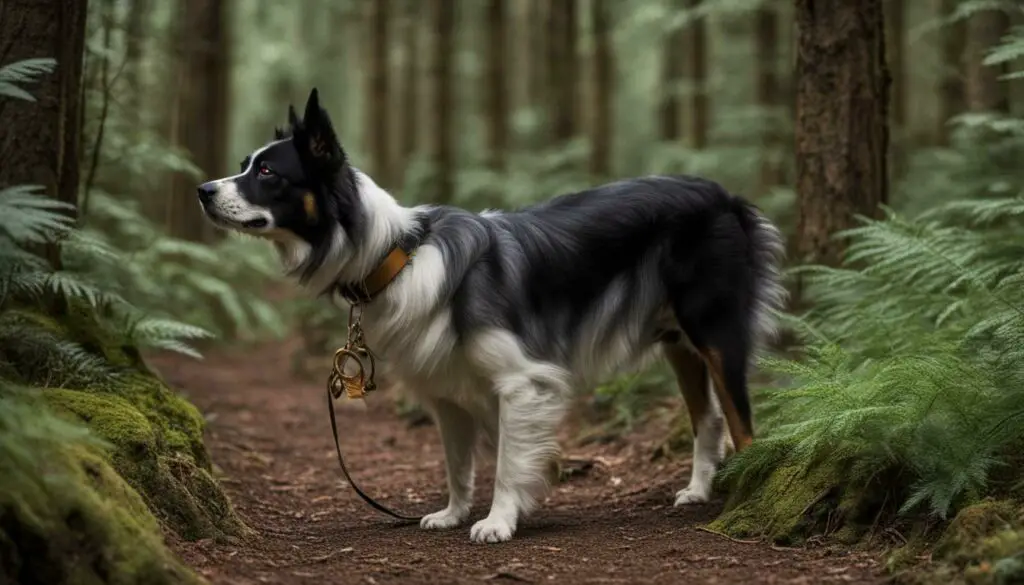Losing a furry friend can be a distressing experience, but with the right strategies and tips, you can increase your chances of finding your lost dog.
Finding a lost dog can be a stressful and challenging experience. According to the American Humane Association, approximately 10 million pets go missing each year. Without proper identification like ID tags or microchips, only a small percentage of these pets are reunited with their owners. However, by remaining calm and systematic in your search efforts, you can improve your chances of bringing your beloved pet back home.
Key Takeaways:
- Start your search by thoroughly checking your home, yard, and immediate neighborhood for your lost dog.
- Involve your neighbors, friends, and local social media networks to gain support and assistance in locating your missing pet.
- Utilize pet trackers or lost pet apps to aid in the search and increase the chances of finding your dog.
- Reach out to animal shelters, veterinary hospitals, and rescue groups in your area for additional help and resources.
- Create and distribute lost dog flyers with a clear description and your contact information to spread the word.
Remember to update your dog’s ID tags and microchip information to ensure that your contact details are current and easily accessible. Additionally, notify local shelters, veterinary offices, and online lost dog forums about your missing pet to maximize your chances of a successful reunion. Tools like PetHub can also be helpful in the search for your lost dog.
If you happen to find a lost dog during your search, bring it to your local animal shelter and report it to veterinary offices in case the owner comes looking.
Conduct a Thorough Search at Home and Immediate Neighborhood
When your dog goes missing, the first and most crucial step is to conduct a thorough search within your home and immediate neighborhood. Start by carefully checking every room in your house, including hidden spaces like closets or under furniture. Dogs can sometimes find small, cozy spots to hide, especially if they are scared or anxious.
Don’t forget to thoroughly search your yard, paying close attention to any potential hiding places such as bushes, sheds, or under decks. Your dog may have found a comfortable spot where they feel safe. Additionally, it’s important to search your immediate neighborhood, as your dog may have wandered off nearby.
During your search, it’s essential to remain calm and be systematic. Create a checklist of areas to search and mark them off as you go. Use treats, toys, or familiar scents to try and lure your dog out if they are hiding. Remember, dogs have a keen sense of smell, so even if you can’t see or hear them, they may be able to pick up on familiar scents.
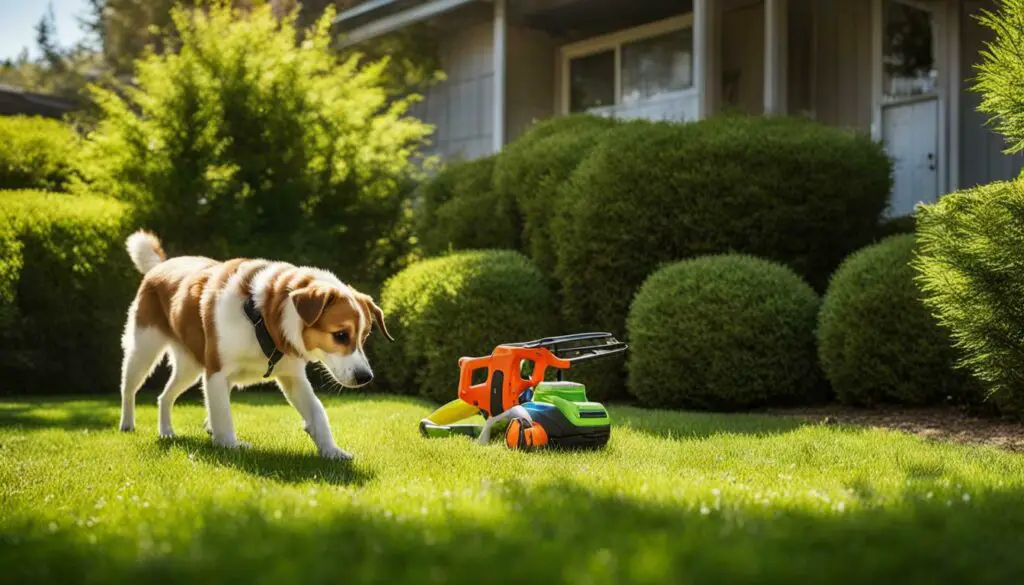
Remember, timing is crucial when searching for a lost dog. The sooner you start your search, the better your chances of finding them quickly. Don’t delay, act fast!
While conducting your search, it’s important to enlist the help of family members, neighbors, and friends. They can assist in the search, covering more ground and increasing the chances of finding your beloved pet. Distribute clear photos and a description of your dog, highlighting any identifiable markings or features that can help people recognize them.
| Checklist for Conducting a Thorough Search |
|---|
| Search every room in your house, including hidden spaces. |
| Thoroughly check your yard, paying attention to potential hiding places. |
| Systematically search your immediate neighborhood. |
| Use treats, toys, or familiar scents to lure your dog out if they are hiding. |
| Enlist the help of family members, neighbors, and friends. |
Remember, finding a lost dog requires patience, persistence, and a carefully planned search strategy. Stay positive and remain hopeful, as dogs have been known to find their way back home even after being missing for several days. By conducting a thorough search at home and in your immediate neighborhood, you’re taking the first steps towards reuniting with your furry friend.
Engage Your Community in the Search
Don’t underestimate the power of your community when it comes to finding a lost dog – their help and support can make a significant difference. When your furry friend goes missing, reaching out to your neighbors, friends, and local social media networks can greatly increase your chances of a successful reunion.
Start by spreading the word about your lost dog to those in your immediate area. Create a post on social media platforms like Facebook or Nextdoor, providing a clear description of your pet and any distinguishing features. Share a recent photo, if possible, to help people recognize your dog if they spot them.
Consider organizing a search party with volunteers from your community. Assign specific areas to search and provide them with flyers or posters to distribute. This not only increases awareness but also encourages others to keep an eye out for your missing pet. Remember to include your contact information on the flyers so that anyone who spots your dog can easily reach you.
Additionally, consider contacting local animal shelters, rescue groups, and veterinary offices. They may have seen or received information about a lost dog matching your pet’s description. Provide them with all the necessary details and ask if they can keep an eye out or share the information with their network.
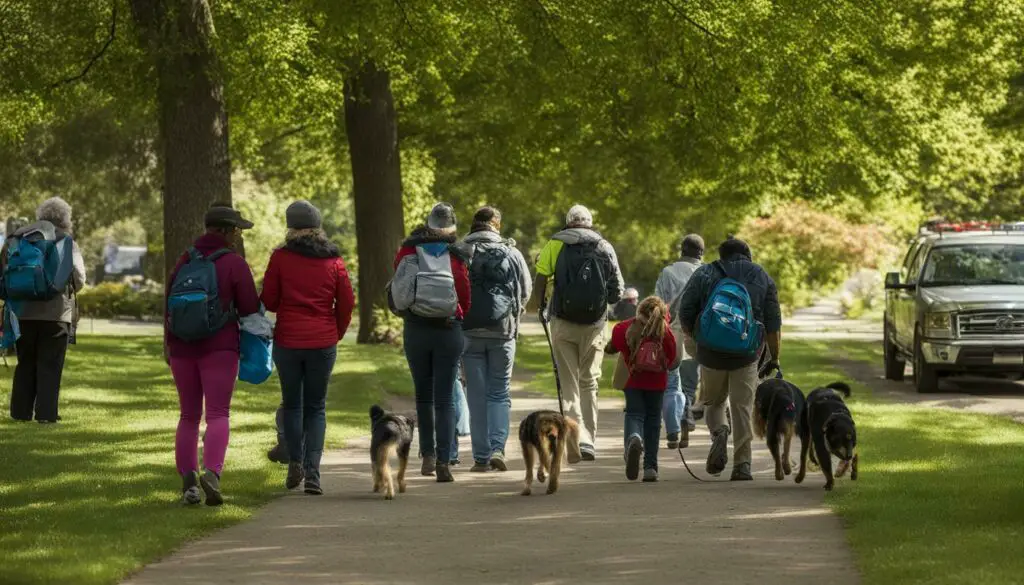
| Tips for Engaging Your Community: |
|---|
| Create a post on social media platforms with a clear description and recent photo of your lost dog. |
| Organize a search party with volunteers from your community and distribute flyers in the designated search areas. |
| Contact local animal shelters, rescue groups, and veterinary offices to provide them with your dog’s information. |
Utilize Pet Trackers and Lost Pet Apps
Technology has made it easier than ever to track and locate a lost dog, with pet trackers and lost pet apps providing valuable assistance in the search. These innovative tools can help pet owners monitor their furry friends‘ whereabouts and increase the chances of a successful reunion.
Pet trackers are devices that can be attached to a dog’s collar or harness, allowing owners to track their pet’s location in real-time. Some trackers even offer additional features like geofencing, which sends an alert if the pet leaves a designated safe zone. With the help of GPS technology, these trackers provide peace of mind and enable pet owners to quickly locate a lost dog.
Lost pet apps are another useful tool in the search for a missing dog. These apps allow pet owners to create a digital profile for their pet, complete with a description, photos, and contact information. If a dog goes missing, users can activate a lost pet alert, which sends a notification to nearby app users and local animal shelters. This widespread reach increases the chances of someone spotting the lost dog and reaching out to the owner.
| Pet Tracker Benefits: | Lost Pet App Benefits: |
|---|---|
| Real-time location tracking | Wide-reaching lost pet alerts |
| Geofencing capabilities | Ability to create a digital profile |
| Helpful for dogs that tend to wander | Increased visibility in the community |
When using pet trackers and lost pet apps, it is essential to ensure that the devices are properly charged and always accessible. Regularly update the apps with your dog’s latest information, including photos and any unique identifiers. Additionally, register your pet’s microchip information on the app, if applicable, to have all identification details in one convenient location.
Remember, while technology can be a valuable tool in the search for a lost dog, it should be used in conjunction with other strategies, such as searching the immediate neighborhood, engaging the community, and distributing lost dog flyers. By combining these efforts, pet owners can increase their chances of finding their furry friends and bringing them safely back home.

Reach Out to Animal Shelters, Veterinary Hospitals, and Rescue Groups
Animal shelters, veterinary hospitals, and rescue groups are invaluable resources in the search for a lost dog, as they have the expertise and network to assist in reuniting pets with their owners. When your dog goes missing, it is important to reach out to these organizations as soon as possible. They often have access to databases and lost pet reports, increasing the chances of finding your furry friend.
Start by contacting local animal shelters and providing them with a detailed description of your dog, including any identifying features or markings. Share recent photographs and your contact information so they can reach out if your dog is brought in. It’s also a good idea to visit the shelters in person to check for yourself, as descriptions can sometimes be subjective. Remember to bring a photo of your dog and any supporting documents, such as vaccination records or microchip information.
In addition to animal shelters, veterinary hospitals are another important resource to contact. Notify them about your missing dog and provide them with the same information you shared with the shelters. If someone finds your dog and takes them to a veterinary office, they can scan for a microchip or check if your dog matches any reports of lost pets. Many veterinary hospitals also have bulletin boards where they display flyers of lost and found pets, so be sure to provide them with a copy of your dog’s flyer.
Rescue groups, especially those specializing in your dog’s breed or type, are also worth reaching out to. They may have connections and followers who can help spread the word about your lost pet. They are often experienced in handling lost dog cases and can provide guidance and support during this stressful time. Make sure to provide them with your contact information and keep them updated on any developments in your search.
| Contact Information | Hours of Operation |
|---|---|
| Local Animal Shelter | Monday-Friday: 9am-5pm |
| Veterinary Hospital | Monday-Saturday: 8am-6pm |
| Rescue Group | Varies, check their website |
Key Takeaways:
- Contact local animal shelters, veterinary hospitals, and rescue groups when your dog goes missing.
- Provide them with a detailed description, photographs, and your contact information.
- Visit the shelters in person and check their bulletin boards for lost and found pet flyers.
- Notify veterinary hospitals and ask them to scan for a microchip or match your dog with any lost pet reports.
- Reach out to breed-specific or type-specific rescue groups for additional support.
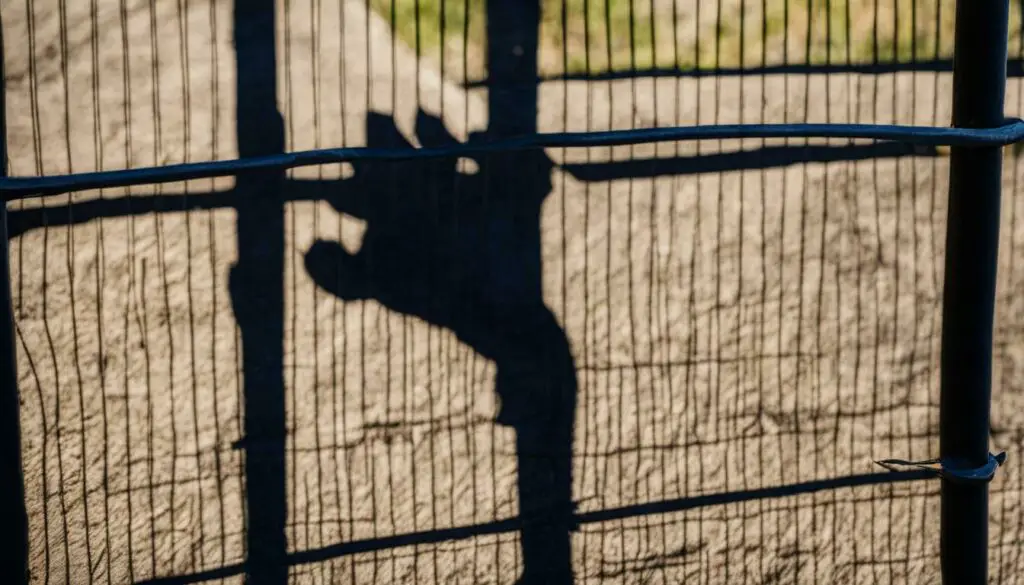
Create and Distribute Lost Dog Flyers
Lost dog flyers are a traditional yet highly effective method of spreading the word about your missing pet and engaging the community in the search. These flyers serve as visual reminders and provide crucial information to anyone who might come across your lost dog. By creating and distributing these flyers, you increase the chances of someone spotting your furry friend and notifying you.
To create an impactful flyer, include a clear and recent photo of your dog along with a description that highlights their unique features. Make sure to include your contact information, such as your phone number and email address, so that people can reach out to you if they have any information. Additionally, consider offering a reward to incentivize individuals to keep an eye out for your pet.
When distributing the flyers, focus on high-traffic areas such as local parks, community bulletin boards, pet stores, and veterinary offices. You can also ask local businesses if they would be willing to display your flyer in their storefronts. Social media platforms can also be utilized to share the flyer with your network and encourage others to do the same.
Remember, the more flyers you distribute, the greater the chances of someone spotting your lost dog and contacting you. Stay positive and proactive, and continue distributing flyers even after the initial search. With the help of the community and the visibility of the flyers, you increase the likelihood of a reunion with your beloved pet.
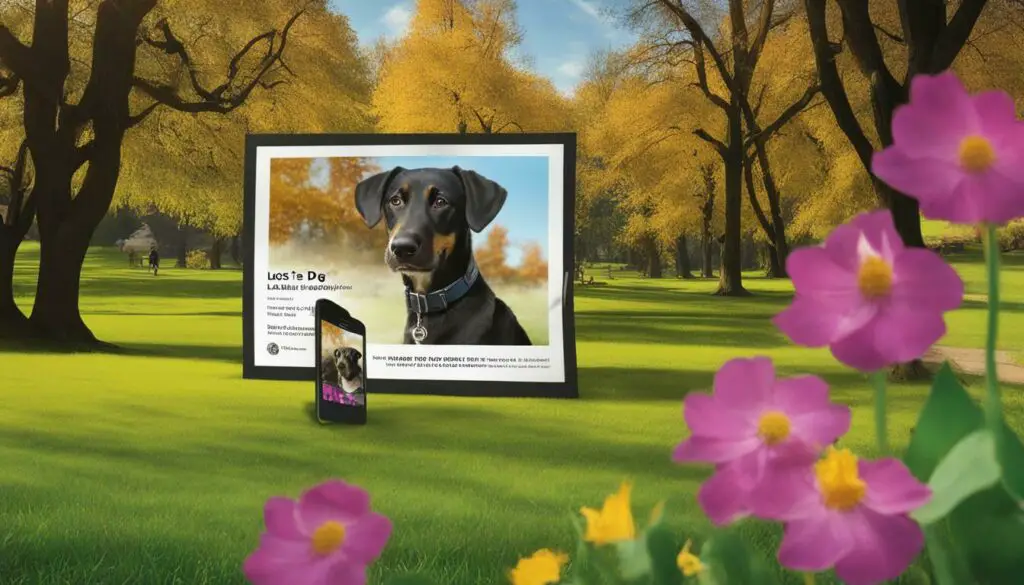
| Key Elements of a Lost Dog Flyer | Tips for Effective Distribution |
|---|---|
|
|
Update Your Dog’s ID Tags and Microchip Information
Preventing potential future lost dog situations is just as important as finding your current missing pet – updating your dog’s ID tags and microchip information is crucial for a successful reunion. Ensuring that your contact information is current and easily accessible can greatly increase the chances of being reunited with your beloved pet.
Start by checking your dog’s ID tags. Are they still readable? Is the information accurate? If not, it’s time to update them. The American Humane Association recommends including your name, phone number, and address on the tag. You may also want to consider adding a secondary contact number or an emergency number. Choose a durable material that won’t wear off easily, and regularly check for any signs of damage or fading.
In addition to ID tags, microchipping your dog is a highly effective way to ensure their identification. A microchip is a small, rice-sized device that is implanted under your dog’s skin. It contains a unique identification number that can be scanned by a veterinarian or animal shelter. This number is linked to your contact information in a database, making it easier for them to contact you if your dog is found.
| Benefits of Updating Your Dog’s ID Tags and Microchip Information |
|---|
| Increases the chances of being reunited with your lost dog |
| Ensures accurate contact information for quick notification |
| Provides peace of mind knowing your dog is properly identified |
Remember, your dog’s ID tags and microchip information are only effective if the details are up to date. If you move or change your phone number, make sure to update the information in the microchip database as well as on the ID tags. Regularly check that the contact information is accurate and easily readable. Taking these simple steps can significantly increase the chances of being reunited with your furry friend in the event they go missing.
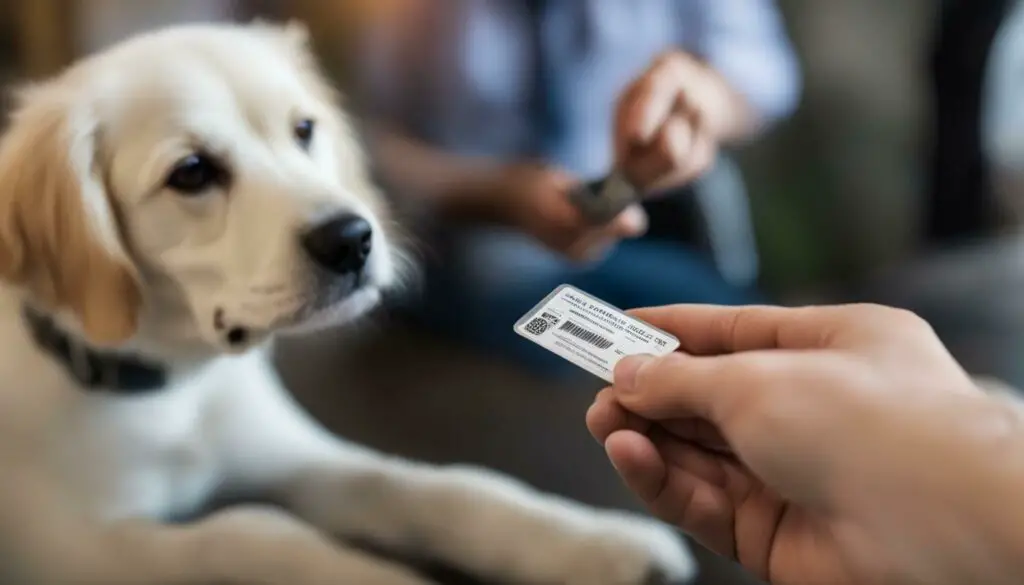
“Microchipping your dog is like giving them a voice. It is a permanent way to ensure their identification, even if their collar or tags get lost,” says Dr. Emily Richardson, a veterinarian with over 10 years of experience.
“Updating your dog’s ID tags and microchip information is a small investment of time and effort, but it can make a world of difference in bringing your lost pet back home.”
Summary:
- Preventing future lost dog situations is crucial – update your dog’s ID tags and microchip information.
- Check your dog’s ID tags for readability and accuracy. Use durable materials and regularly inspect for damage.
- Microchipping provides an additional layer of identification. Ensure your contact information is up to date in the microchip database.
- Benefits of updating your dog’s ID tags and microchip information include increased chances of reunion, accurate contact information, and peace of mind.
- Remember to regularly check and update the contact details on your dog’s ID tags and in the microchip database.

Notify Local Shelters, Veterinary Offices, and Online Lost Dog Forums
In addition to conducting your own search, notifying local shelters, veterinary offices, and online lost dog forums can significantly increase your chances of finding your beloved pet. These organizations and platforms have extensive networks and resources that can help spread the word and assist in reuniting owners with their missing dogs.
When contacting local shelters and veterinary offices, provide them with a detailed description of your lost dog, including any identifying features, breed, size, and temperament. This information will help them identify your pet if it is brought to their facility or if they come across any potential matches.
Online lost dog forums are another valuable tool in your search efforts. These platforms allow you to connect with a larger community of pet lovers who are eager to help reunite lost dogs with their owners. Post a clear description of your lost dog, along with your contact information, in these forums. Be sure to include relevant keywords such as “finding a lost dog” and “lost pet search” to increase visibility and attract the attention of those who may have seen your dog.
Remember, time is of the essence when searching for a lost dog, so it is crucial to notify these organizations as soon as possible. Stay hopeful and continue to explore all available avenues in your search. With the help of your community and the resources provided by local shelters, veterinary offices, and online forums, the chances of finding your beloved pet are greatly increased.
Use Tools Like PetHub
PetHub is a valuable tool that can enhance your efforts to find a lost dog, providing additional resources and visibility to aid in the search. With PetHub, you can create a customized online profile for your pet, complete with their photo, description, and your contact information. This profile can be easily accessed by anyone who finds your lost dog, increasing the chances of a successful reunion.
In addition to the profile, PetHub also offers QR code tags that can be attached to your pet’s collar. These tags are scannable by anyone with a smartphone, allowing them to quickly access your pet’s information and contact you if they are found. This eliminates the need for strangers to physically handle your pet or search for identification tags, making the process more efficient and hassle-free.
Furthermore, PetHub has a vast network of partners, including animal shelters, veterinary offices, and other pet-related organizations. When you report your lost dog on PetHub, the information is shared with these partners, increasing the chances of someone spotting your pet or providing relevant leads. This network effect greatly expands the reach of your search efforts and maximizes the number of eyes on the lookout for your beloved furry friend.
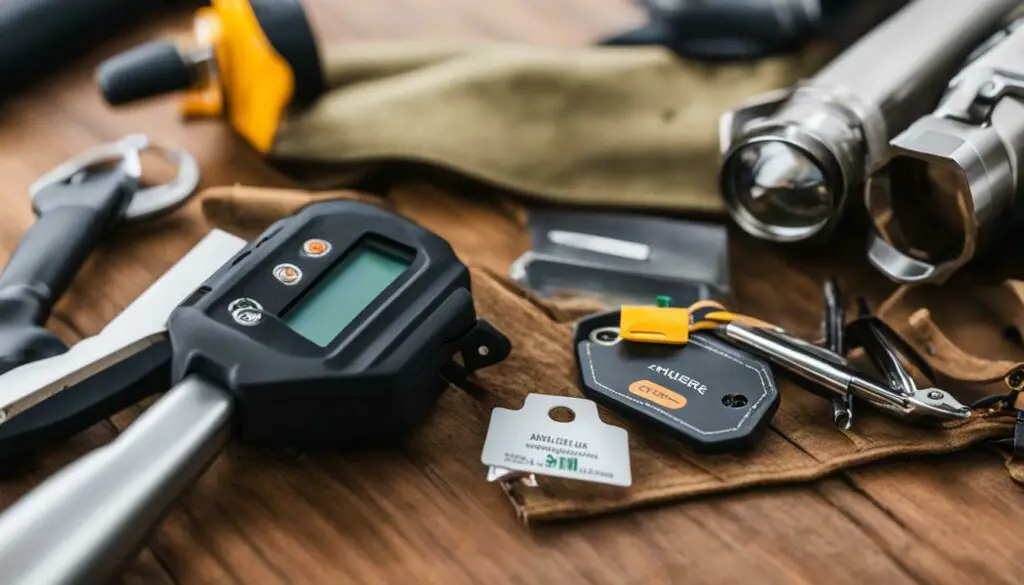
Benefits of Using PetHub:
- Customized online profile for your pet with contact information
- QR code tags for easy access to your pet’s information
- Extensive network of partners for increased visibility and leads
“PetHub helped me find my lost dog within hours of reporting him missing. The online profile and QR code tags made it easy for someone to contact me when they found him. I am forever grateful for this amazing tool!” – Melissa S.
| Lost Dog Tips: |
|---|
| Thoroughly search your home and immediate neighborhood |
| Engage your community and spread the word |
| Utilize pet trackers and lost pet apps |
| Reach out to animal shelters, veterinary hospitals, and rescue groups |
| Create and distribute lost dog flyers |
| Update your dog’s ID tags and microchip information |
| Notify local shelters, veterinary offices, and online lost dog forums |
| Use tools like PetHub |
| Know what to do if you find a lost dog |
What to Do If You Find a Lost Dog
If you come across a lost dog while searching for your own missing pet, there are important steps to follow to ensure the dog has the best chance of being reunited with its owner. First, approach the dog calmly and slowly. Avoid sudden movements or loud noises that could startle them. If the dog is friendly and allows you to approach, check for any identification tags or a collar with a contact number. If the dog has tags, call the owner immediately and let them know you have found their pet. If there are no tags, you can try taking the dog to a local animal shelter or veterinary office to be scanned for a microchip.
If you are unable to reach the owner or there are no identification tags or microchip, consider bringing the dog to a nearby veterinary office or animal shelter. They can check for a microchip and take the necessary steps to reunite the dog with its owner. It is important to let these organizations know that you found a lost dog, as they often have a network to help locate the owner.
While waiting for the owner to be located, ensure the dog is safe and comfortable. Provide food and water, if possible, and create a temporary shelter with blankets or towels. If the dog seems scared or anxious, try to create a calm and quiet environment for them. Sharing a photo of the found dog on social media or local lost pet forums can also help increase the chances of finding the owner quickly.
Remember, finding a lost dog can be a stressful experience for both the dog and their owner. By following the steps outlined above, you can play a vital role in reuniting a lost dog with their loving family. Your kindness and compassion may be the key to bringing joy and relief to both the owner and the lost dog.

| Summary of Steps to Take |
|---|
| 1. Approach the dog calmly and slowly |
| 2. Check for identification tags or collar and call the owner if possible |
| 3. Bring the dog to a local animal shelter or veterinary office to be scanned for a microchip |
| 4. If unable to reach the owner or no identification tags or microchip, bring the dog to a nearby veterinary office or animal shelter |
| 5. Ensure the dog is safe and comfortable while waiting for the owner |
| 6. Share a photo of the found dog on social media or local lost pet forums |
Conclusion
Finding a lost dog can be a stressful and challenging experience, but with the proven strategies and tips shared in this article, you can increase your chances of finding your beloved pet and experiencing the joy of a reunion.
According to the American Humane Association, approximately 10 million pets go missing each year. Without proper identification, only a small percentage of these pets are reunited with their owners. That’s why it’s crucial to take immediate action and remain calm during your search.
Start by thoroughly searching your home, yard, and immediate neighborhood. Be systematic and cover every possible hiding spot. Don’t forget to involve your neighbors, friends, and local social media networks. Utilize pet trackers or lost pet apps to help track your dog’s whereabouts and increase the chances of a successful reunion.
Reach out to animal shelters, veterinary hospitals, and rescue groups in your area. They can provide guidance and support in your search efforts. Creating and distributing lost dog flyers with a clear description and contact information is also essential. Update your dog’s ID tags and ensure that the information is current. Microchipping is highly recommended as an additional layer of identification.
Don’t hesitate to notify local shelters, veterinary offices, and online lost dog forums. The more people who are aware of your missing pet, the higher the chances of someone recognizing and reporting a sighting. Tools like PetHub can also be incredibly helpful in the search for your lost dog.
Lastly, if you find a lost dog during your search, bring it to your local animal shelter and report it to veterinary offices in case the owner comes looking. Your compassion and willingness to help someone else find their beloved pet can make all the difference.
Remember, finding a lost dog takes time and effort, but by following these proven strategies and tips, you can increase your chances of a successful reunion. Stay positive and never give up hope!
FAQ
How can I increase my chances of finding a lost dog?
By following proven strategies and tips, such as conducting a thorough search at home and in the immediate neighborhood, engaging your community in the search, utilizing pet trackers and lost pet apps, reaching out to animal shelters, veterinary hospitals, and rescue groups, creating and distributing lost dog flyers, updating your dog’s ID tags and microchip information, notifying local shelters, veterinary offices, and online lost dog forums, using tools like PetHub, and reporting any found dogs to local authorities.
What should I do if my dog goes missing?
Remain calm and start by searching your home, yard, and immediate neighborhood. Involve your neighbors, friends, and local social media networks in the search. Use pet trackers or lost pet apps to help locate your dog. Reach out to animal shelters, veterinary hospitals, and rescue groups in your area. Create and distribute lost dog flyers with a clear description and contact information. Update your dog’s ID tags and keep the information current. Notify local shelters and veterinary offices, and consider posting on online lost dog forums and using tools like PetHub.
How can I engage my community in the search for my lost dog?
You can engage your community by informing your neighbors, friends, and local social media networks about your missing dog. Share a clear description and photo of your dog, along with your contact information. Ask them to keep an eye out and share the information with others. Consider organizing search parties or distributing flyers in the neighborhood to spread the word.
Are there any tools or apps that can help me find my lost dog?
Yes, there are pet trackers and lost pet apps available that can help you locate your lost dog. These tools often utilize GPS technology and allow you to track your dog’s whereabouts in real-time. Some popular options include Whistle, Tile, and Pawscout.
Should I notify local shelters and veterinary offices if my dog goes missing?
Yes, it is crucial to notify local animal shelters and veterinary offices about your missing dog. Provide them with a detailed description and any identifying features. They can keep an eye out for your dog and notify you if he or she is found. It is also recommended to regularly check their websites or lost pet databases for any new arrivals.
How can I create effective lost dog flyers?
When creating lost dog flyers, include a clear photo of your dog, a description of their characteristics and any identifying features, your contact information, and the date and location where your dog went missing. Make sure the flyer is easily readable and eye-catching. Distribute the flyers in high-traffic areas, local businesses, veterinary offices, and animal shelters.
Is microchipping my dog important for finding them if they go missing?
Yes, microchipping your dog is highly recommended. Even if your dog loses their collar with ID tags, a microchip provides a permanent form of identification. It is crucial to keep the microchip information updated with your current contact details. If your dog is found and taken to a veterinary office or animal shelter, they can scan for the microchip and reunite you with your beloved pet.
Are there any online resources or forums specifically for lost dogs?
Yes, there are various online resources and forums dedicated to helping find lost dogs. Websites and platforms like Petfinder, LostMyDoggie, and PawBoost allow you to create listings for your missing dog and reach a wider audience. Utilize these resources to increase the chances of finding your lost pet.
What should I do if I find a lost dog during my search?
If you find a lost dog, it is important to bring them to your local animal shelter or report it to veterinary offices in your area. They can scan for a microchip or take necessary steps to reunite the dog with their owner. It’s crucial not to assume ownership of the dog, as someone else may be desperately searching for their beloved pet.
How common is it for lost dogs to be reunited with their owners?
Unfortunately, only a small percentage of lost dogs are reunited with their owners if they do not have ID tags or microchips. The American Humane Association estimates that about 10 million pets go missing each year. Therefore, it is vital to follow the strategies and tips mentioned to increase the chances of finding your lost dog and bringing them back home.

